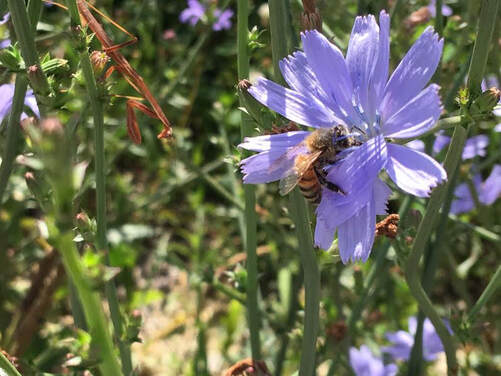 Honey bee on a chicory flower July 2019.
Honey bee on a chicory flower July 2019.
Gardener Recipes and Guides
Beekeepers are also gardeners, if for no other reason to be aware of what pollen and nectar bees are bringing home. The following are "recipes" associated with providing food for bees or repelling bugs without harming bees:
Natural Bug Repellent
Dishwashing liquid
Spray bottle with water
Add several drops of dishwashing liquid to spray bottle. Shake, Apply to plants to repel bugs. Re-apply after rain.
Note: do not spray on bees, this will also kill them. If you need to humanely dispatch bees, you can use this recipe.
Bob Brammer's Wax Moth and Yellow Jacket Trap Recipe
1 cup water
1 cup sugar
1/2 cup vinegar
1 banana peel
Mix and place in 1 gallon jug with a one-inch hole cut near the top. Hang from a tree.
How to Make Seed Bombs (shared by Kelly S. Bracken August 23, 2015)
To make seed bombs, you need
Clay - from your area or air dry clay. Red clay used to make garden pots is best as it contains more minerals, but it's not required. I usually dig up some MO dirt that is clay-ish looking, put into a bucket, add water and stir it up. Silt and rocks will settle to the bottom. After it settles, pour off excess water. Remove clay with old, large kitchen spoon until you begin to hit the silt layer in the bucket. Place wet clay in any old tray or cake pan. Place in full sun to dry. If raining, place in oven at 100 degrees until water is evaporated. Now you have dry clay.
Water in a spray bottle gives you the best control over how much you use.
Compost or worm castings
Native seeds
Flat surface
Directions: Mix 5 parts clay with 1 part compost by weight. Add enough clay to the mix to form a tight ball of mix that will not crumble. Knead with hands into a ball. You can mix in flower seeds or add them after rolling mixture together.
Add powdered Cayenne pepper to the mix. This will prevent insects, birds, mice, and squirrels from getting to seeds. If adding Cayenne, WEAR GLOVES WHEN MIXING.
Let air dry in sun or inside house until compacted.
Plant by making holes, then dropping them in and watering. I plant close to first frost, after it's rained and ground is moist. You can plant after first frost, too, as long as you can make a hole in the ground with your dibble stick. The point is to get them in before winter for 'cold stratification' of the seeds. The hole is only to be a depression or "nest" to hold the seed bomb securely. Don't make a deep hole. Don't step on the ball after you drop it into the 'hole' or the outer protective layer of clay is lost. Let the elements break down the ball over the winter.
There is no need to water the ball after placing in its nest here in MO. It's extra work that's not necessary and can make you slip if one is planting on a slope.
Here's a 2 minute vid that gets the process across quickly: https://youtu.be/GM7DfPvGrO4
This video is 30 minutes but shows, at the end, a home made tumbler to make larger quantities of seed balls. https://youtu.be/dWyduWsoy8o
